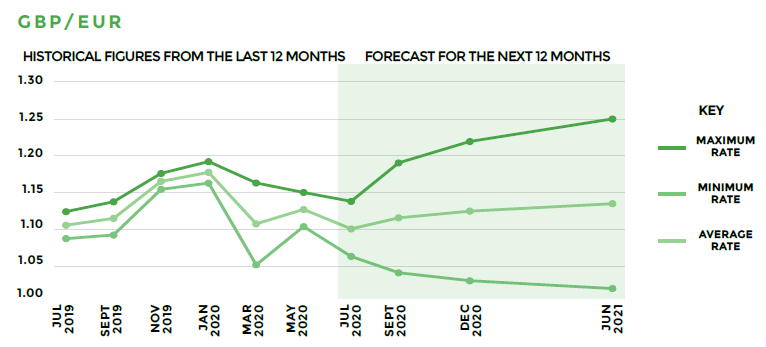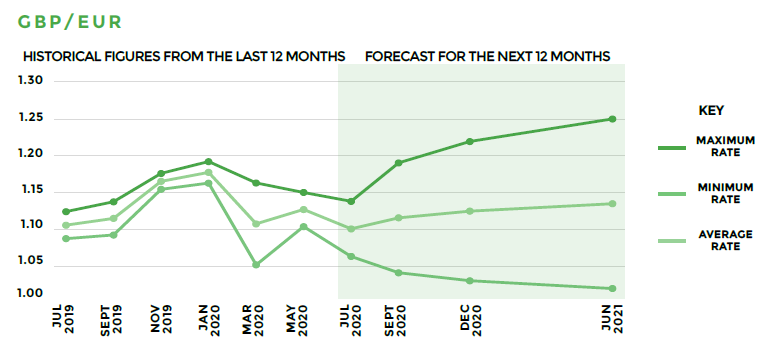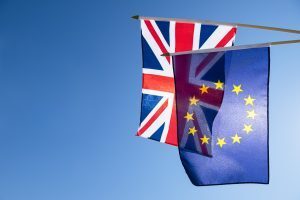The progress of Brexit talks and worries over the UK’s economy have been major factors in determining the pound’s movements recently. With the UK and EU keeping cards close to their chests so far, there’s uncertainty over how negotiations will play out over the next few months. As regards the economy, much relies on control of the virus and the actions of the public.
It’s safe to say that no one, not even the banks, can predict the outcome of these events. Therefore, it’s very difficult to forecast how the pound might move.
Nevertheless, we’ve collated predictions from major banks and highlighted key factors which may influence the pound, euro and dollar in our latest quarterly forecast. It certainly makes for an interesting read, not least because the forecasts show a huge disparity.
Pound versus Euro
According to some analysts, GBP/EUR could reach around €1.04 in the next three months. Not everyone is quite so pessimistic. Predictions stretch as high as €1.19 but settling at an average of €1.09.

The pound has been responding to, and will probably continue to be impacted by, a number of different factors. Brexit negotiations have shown little progress, despite the unchanging transition period deadline. With talks continuing at a rapid pace in July and sticking points on both sides, it will be interesting to see if any real developments materialise soon. There have been reports that we could see either a no-deal or a very basic, ‘Australian’ style deal. Neither prospect has fared well with the pound.
The euro has gained momentum when the agreement between EU member states over the coronavirus recovery fund was made. It is designed to help EU countries that have struggled more than others due to the coronavirus crisis. This deal is not only positive for the economy but also shows that the union itself is strong.
The euro could continue to strengthen on this basis. However, in recent days EUR/GBP has taken a hit due to worse than expected Eurozone economic data.
Pound versus Dollar
Early in the pandemic the dollar was supported by its status as a safe haven. Investors turn to the dollar in times of market distress, giving it a boost. Or at least they used to. Will USD remain the world’s ‘reserve currency’? Some have their doubts, hence gold’s rocketing value.
In our forecasts the most optimistic predictions by September is a recovery to $1.38. While the majority of leading banks had sterling trading in the mid-$1.20s, some institutions offer a more modest prediction at $1.15.
Again, recent events have overtaken our forecasters, with the US dollar falling compared to most currencies as the pandemic takes hold once again, and currently already trading at over $1.30 against sterling. Few predicted that!

By the time that September comes around, the Presidential election will be a major factor in determining the dollar’s movements. In the report we analyse what Joe Biden leading decisively in the polls could do.
Euro versus Dollar
Predictions for EUR/USD show a huge disparity. However, the average for the next 12 months stays around the 1.15 mark.

There are predictions that if the euro continues to strengthen, it could even replace the dollar as the reserve currency of choice. However, there are probably a few factors that will stop that from happening just yet.
For now, rising infection rates in the US and the impact that this has on the US economy could impact the dollar, whilst signs of economic recovery in the Eurozone are likely to help the euro.






















